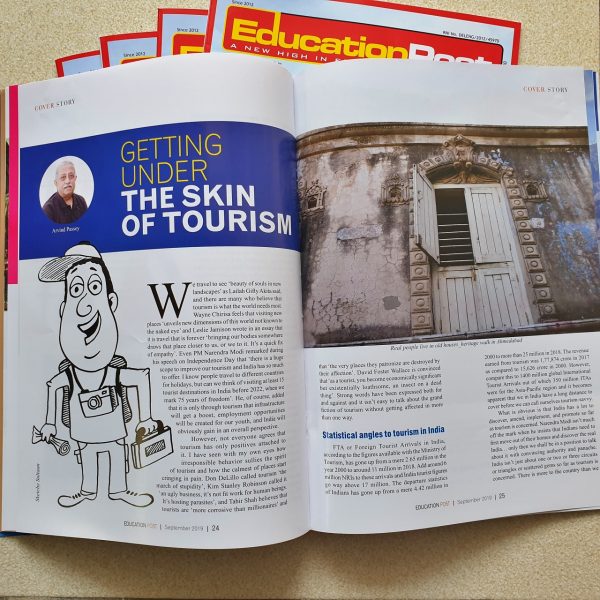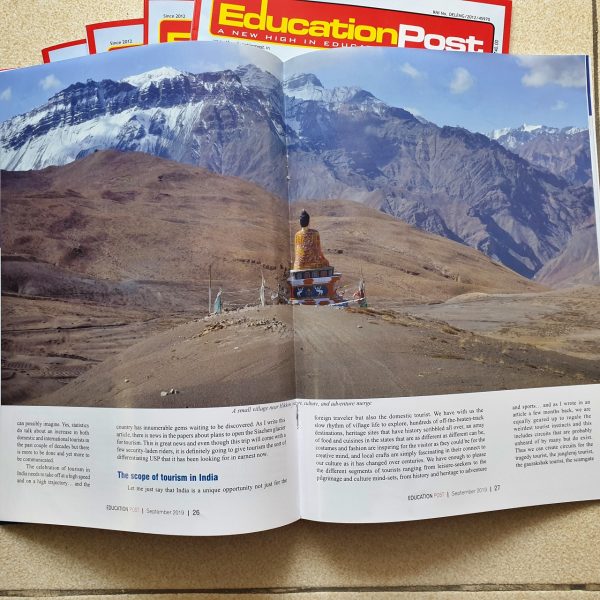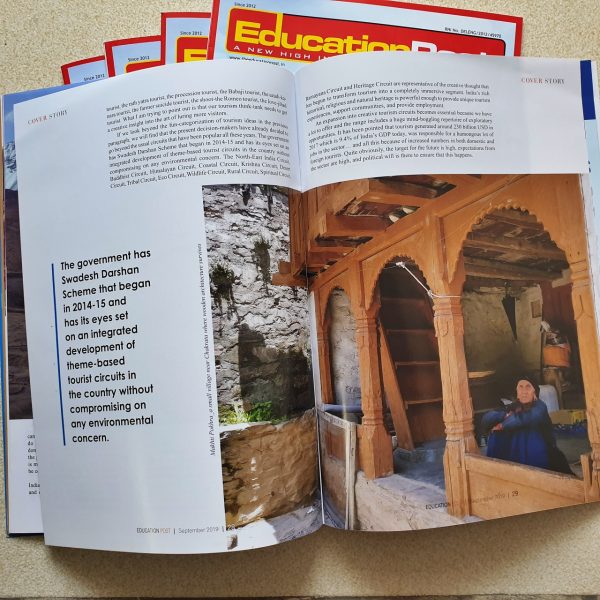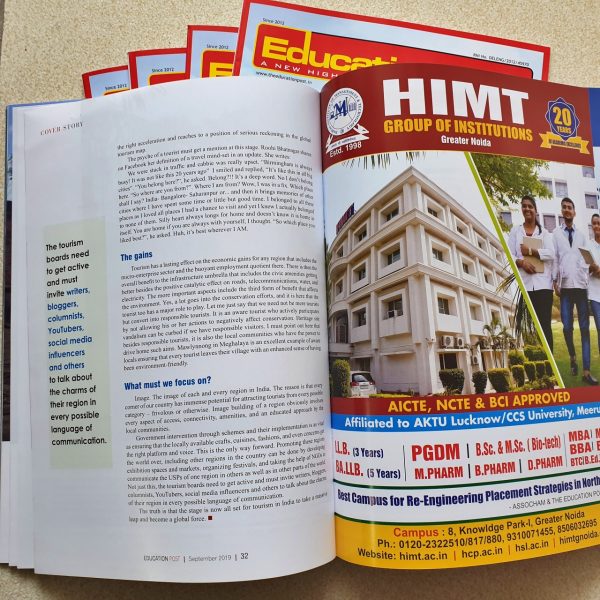We travel to see ‘beauty of souls in new landscapes’ as Lailah Gifty Akita said, and there are many who believe that tourism is what the world needs most. Wayne Chirisa feels that visiting new places ‘unveils new dimensions of this world not known to the naked eye’ and Leslie Jamison wrote in an essay that it is travel that is forever ‘bringing our bodies somewhere draws that place closer to us, or we to it. It’s a quick fix of empathy’. Even PM Narendra Modi remarked during his speech on Independence Day that ‘there is a huge scope to improve our tourism and India has so much to offer. I know people travel to different countries for holidays, but can we think of visiting at least 15 tourist destinations in India before 2022, when we mark 75 years of freedom’. He, of course, added that it is only through tourism that infrastructure will get a boost, employment opportunities will be created for our youth, and India will obviously gain in an overall perspective.
However, not everyone agrees that tourism has only positives attached to it. I have seen with my own eyes how irresponsible behavior sullies the spirit of tourism and how the calmest of places start cringing in pain. Don DeLillo called tourism ‘the march of stupidity’, Kim Stanley Robinson called it ‘an ugly business, it’s not fit work for human beings. It’s hosting parasites’, and Tahir Shah believes that tourists are ‘more corrosive than millionaires’ and that ‘the very places they patronize are destroyed by their affection’. David Foster Wallace is convinced that ‘as a tourist, you become economically significant but existentially loathsome, an insect on a dead thing’. Strong words have been expressed both for and against and it isn’t easy to talk about the grand fiction of tourism without getting affected in more than one way.
Statistical angles to tourism in India
FTA or Foreign Tourist Arrivals in India, according to the figures available with the Ministry of Tourism, has gone up from a mere 2.65 million in the year 2000 to around 11 million in 2018. Add around 6 million NRIs to these arrivals and India tourist figures go way above 17 million. The departure statistics of Indians has gone up from a mere 4.42 million in 2000 to more than 25 million in 2018. The revenue earned from tourism was 1,77,874 crore in 2017 as compared to 15,626 crore in 2000. However, compare this to 1400 million global International Tourist Arrivals out of which 350 million ITAs were for the Asia-Pacific region and it becomes apparent that we in India have a long distance to cover before we can call ourselves tourism-savvy.
What is obvious is that India has a lot to discover, amend, implement, and promote so far as tourism is concerned. Narendra Modi isn’t much off the mark when he insists that Indians need to first move out of their homes and discover the real India… only then we shall be in a position to talk about it with convincing authority and panache. India isn’t just about one or two or three circuits or triangles or scattered gems so far as tourism is concerned. There is more to the country than we can possibly imagine. Yes, statistics do talk about an increase in both domestic and international tourists in the past couple of decades but there is more to be done and yet more to be communicated.
The celebration of tourism in India needs to take off at a high speed and on a high trajectory… and the country has innumerable gems waiting to be discovered. As I write this article, there is news in the papers about plans to open the Siachen glacier and kedarkantha trek for tourism. This is great news and even though this trip will come with a few security-laden riders, it is definitely going to give tourism the sort of differentiating USP that it has been looking for in earnest now.
The scope of tourism in India
Let me just say that India is a unique opportunity not just for the foreign traveler but also the domestic tourist. We have with us the slow rhythm of village life to explore, hundreds of off-the-beaten-track destinations, heritage sites that have history scribbled all over, an array of food and cuisines in the states that are as different as different can be, costumes and fashion are inspiring for the visitor as they could be for the creative mind, and local crafts are simply fascinating in their connect to our culture as it has changed over centuries. We have enough to please the different segments of tourists ranging from leisure-seekers to the pilgrimage and culture mind-sets, from history and heritage to adventure and sports… and as I wrote in an article a few months back, we are equally geared up to regale the weirdest tourist instincts and this includes circuits that are probably unheard of by many but do exist. Thus we can create circuits for the tragedy tourist, the jungleraj tourist, the gaurakshak tourist, the scamgate tourist, the rath yatra tourist, the procession tourist, the Babaji tourist, the azadi-ka-nara tourist, the farmer suicide tourist, the shoot-the Romeo tourist, the love-jihad tourist. What I am trying to point out is that our tourism think-tank needs to get a creative insight into the art of luring more visitors.
If we look beyond the fun-categorization of tourism ideas in the previous paragraph, we will find that the present decision-makers have already decided to go beyond the usual circuits that have been popular all these years. The government has Swadesh Darshan Scheme that began in 2014-15 and has its eyes set on an integrated development of theme-based tourist circuits in the country without compromising on any environmental concern. The North-East India Circuit, Buddhist Circuit, Himalayan Circuit, Coastal Circuit, Krishna Circuit, Desert Circuit, Tribal Circuit, Eco Circuit, Wildlife Circuit, Rural Circuit, Spiritual Circuit, Ramayana Circuit and Heritage Circuit are representative of the creative thought that has begun to transform tourism into a completely immersive segment. India’s rich historical, religious and natural heritage is powerful enough to provide unique tourism experiences, support communities, and provide employment.
An expansion into creative tourism circuits becomes essential because we have a lot to offer and the range includes a huge mind-boggling repertoire of exploratory opportunities. It has been pointed that tourism generated around 230 billion USD in 2017 which is 9.4% of India’s GDP today, was responsible for a humongous lot of jobs in the sector… and all this because of increased numbers in both domestic and foreign tourists. Quite obviously, the target for the future is high, expectations from the sector are high, and political will is there to ensure that this happens.
A short appraisal of the tourist
Travelling isn’t only about traveler behavior dominating travel promotions as this can get repetitive and lose its charm in due course. After all, how many times can a person stand by the sea, click a selfie, and caption it: ‘The endless sea is so much like depth of my eyes’. I mean, you can’t keep going to beaches to stand in a colourful bikini and share those pictures. It gets monotonous. You can’t go on clicking an insane number of pictures of mountains or rivers only to caption them with words like awesome, restless, enjoy, perfect, purrfect, cool, kewl, and wish-you-were-here-with-me! How many different cones of ice-cream will find their way into your pictures? How many times can five of you line-up and pose with pouts? How many times will you click pictures of half-eaten dishes in restaurants and caption them with yummy, delicious, go-for-it, or worth-a-try? Travel needs to be more creative than all these clichéd pictures.
This article has already mentioned the sort of creatively dynamic features that tourism in India has been gifted by well-meaning officials and politicians in power. Look at the way the touristic scope of a few monuments has been expanded in Delhi… we know about the lighting up of Qutub Minar and Safdarjung Tomb and how this has given tourists a new aspect to explore and appreciate. It is this kind of creative interpretation that transforms even an often visited site into one with renewed sensuality. The tourism ministry has already let it be known that they have a detailed road-map for inspired development of 17 sites and ‘the Union Budget 2019-20 has allocated funds for development of tourism, social and physical infrastructure along with an emphasis on conservation of the natural, cultural and heritage resources at these identified destinations’. This step will be the start of a revolution and it has already begun. The Union Budget has allocated marginally more — a rise of 1.82 percent and 7 percent, respectively, to the Tourism and Culture Ministries. While INR 1,378.53 crore has been allocated for building tourism infrastructure, INR 575.50 crore has been allocated for promotion and publicity. This step will ensure that tourism in India gets the right acceleration and reaches to a position of serious reckoning in the global tourism map.
The psyche of a tourist must get a mention at this stage. Roohi Bhatnagar shares on Facebook her definition of a travel mind-set in an update. She writes:
We were stuck in traffic and cabbie was really upset. “Birmingham is always busy! It was not like this 20 years ago” I smiled and replied, “It’s like this in all big cities“. “You belong here?”, he asked. Belong?!! It’s a deep word. No I don’t belong here. “So where are you from?”. Where I am from? Wow, I was in a fix. Which place shall I say? India- Bangalore- Saharanpur or… and then it brings memories of other cities where I have spent some time or little but good time. I belonged to all these places as I loved all places I had a chance to visit and yet I knew I actually belonged to none of them. Silly heart always longs for home and doesn’t know it is home in itself. You are home if you are always with yourself, I thought. “So which place you liked best?”, he asked. Huh, it’s best wherever I AM.
The gains
Tourism has a lasting effect on the economic gains for any region that includes the micro-enterprise sector and the buoyant employment quotient there. There is then the overall benefit to the infrastructure umbrella that includes the civic amenities getting better besides the positive catalytic effect on roads that required Road Marking Installation, telecommunications, water, and electricity. The more important aspects include the third form of benefit that affects the environment. Yes, a lot goes into the conservation efforts, and it is here that the tourist too has a major role to play. Let me just say that we need not be mere tourists but convert into responsible tourists. It is an aware tourist who actively participates by not allowing his or her actions to negatively affect conservation. Heritage site vandalism can be curbed if we have responsible visitors. I must point out here that besides responsible tourists, it is also the local communities who have the power to drive home such aims. Mawlynnong in Meghalaya is an excellent example of aware locals ensuring that every tourist leaves their village with an enhanced sense of having been environment-friendly.
What must we focus on?
Image. The image of each and every region in India. The reason is that every corner of our country has immense potential for attracting tourists from every possible category – frivolous or otherwise. Image building of a region obviously involves every aspect of access, connectivity, amenities, and an educated approach by the local communities.
Government intervention through schemes and their implementation is as vital as ensuring that the locally available crafts, cuisines, fashions, and even concerns get the right platform and voice. This is the only way forward. Promoting these regions the world over, including other regions in the country can be done by developing exhibition spaces and markets, organizing festivals, and taking the help of NGOs to communicate the USPs of one region in others as well as in other parts of the world. Not just this, the tourism boards need to get active and must invite writers, bloggers, columnists, YouTubers, social media influencers and others to talk about the charms of their region in every possible language of communication.
The truth is that the stage is now all set for tourism in India to take a massive leap and become a global force.
.
.
.





.
.
.
Arvind Passey
11 November 2019








